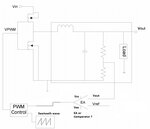viperpaki007
Full Member level 5

- Joined
- Jul 2, 2008
- Messages
- 274
- Helped
- 11
- Reputation
- 22
- Reaction score
- 8
- Trophy points
- 1,298
- Location
- Finland
- Activity points
- 3,437
Hi,
Can somebody tell me what is the difference between error amplifier and and a comparator. Which one i should use in the feedback PWM generation loop of DC-DC converter. (See figure attached).
If i use a comparator to compare Vref and Vout, comparator output can only be either VCC or VEE. It will not make a variable duty cycle waveform to control the DC-DC converter. I need some other kind of circuit like Error amplifier but i am not sure what is the output of error amplifier and why it is different from comparator.
Looking forward for your comments
Can somebody tell me what is the difference between error amplifier and and a comparator. Which one i should use in the feedback PWM generation loop of DC-DC converter. (See figure attached).
If i use a comparator to compare Vref and Vout, comparator output can only be either VCC or VEE. It will not make a variable duty cycle waveform to control the DC-DC converter. I need some other kind of circuit like Error amplifier but i am not sure what is the output of error amplifier and why it is different from comparator.
Looking forward for your comments


